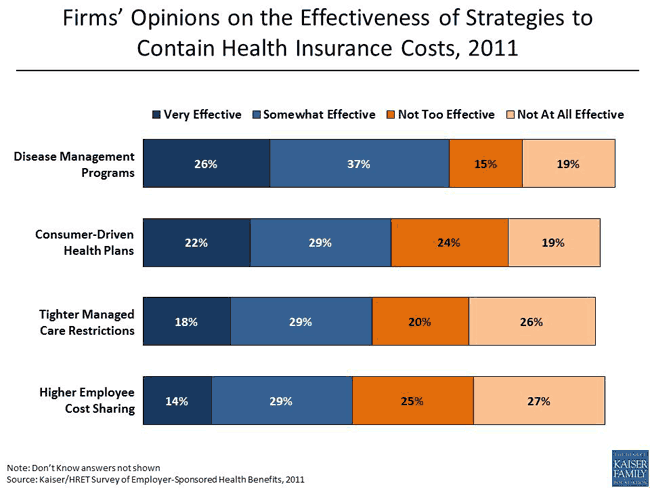Pulling it Together: Business and Health Care Costs
Hidden away on page 218 of our annual Employer Health Benefits Survey is a table that shows what employers think of the main strategies they have to control health care costs. More specifically, the table shows what the person in the firm responsible for its health benefits thinks, which is whom we survey. The short answer is, employer confidence in their own ability to control costs is not high.
Not more than about a quarter of employers felt any one strategy was “very effective,” and they were divided on virtually every cost-containment strategy they were asked about. For example, 22% said consumer-driven health plans were “very effective,” and 19% said they were “not at all effective.” Similarly, 18% said tighter managed care restrictions were “very effective,” while 26% said they were “not at all effective.” The “winner” this year seems to be disease management, garnering the most employer confidence, with 26% calling it “very effective” and 19% calling it “not at all effective.” The not very enthusiastic “somewhat effective” was the description often chosen by employers to characterize the cost-containment strategies available to them. Interestingly, many firms said they don’t have a lot of confidence in increasing employee cost-sharing as a way to decrease costs. Many firms also offer wellness programs, and in an answer to a different question, slightly more than half think those programs help to lower costs to some degree. You can see the results in this chart.

With no single magic bullet strategy they have confidence in, employers tend to try multiple strategies at once in the hope that cumulatively they will have a measurable impact. Large employers have more weapons at their disposal than smaller ones, who, for example, are more likely to offer only one type of health plan (85% of small firms vs. 58% of larger ones). Simply switching plans is often the cost-control strategy of last resort for many firms. About six in ten firms shop for a new plan or new insurer each year, and among those, almost half switch carriers and/or change the type of plan they offer. This produces a remarkable amount of churning in the insurance system. This has been our own experience at the Foundation. Premiums for our main PPO rise to unaffordable levels, we make the changes we can to hold on until premiums rise once more to prohibitive levels, we are told our premiums are up because our cost experience is too high, and then we are forced to switch again.Many years ago, before my time in government and foundations, I did a study of corporate attitudes toward health care costs with colleagues at MIT. We did the study because there was a view at the time that corporations were awakening to health costs in a new way and would become willing allies with government in new efforts to take on this growing problem.
To assess that contention, which was gaining momentum at the time, we interviewed CEOs and corporate health benefits officers at 69 companies, including some of the largest corporations in America. We found that the CEOs, in particular, did not have a great deal of faith in the tools they had to control health care costs (their views were often quite different from those of their health benefits managers). They had little confidence in the ability of businesses and their insurance companies, acting on their own to control costs and they believed the answer (whether market-driven solutions or regulation) had to come from the government, feeling that only government could act on a system-wide scale. Logically then, they would lend their support and considerable clout to back government efforts to control health care costs? Not really.
To the contrary, on a personal level, many of the CEOs we spoke to were opposed to a larger role for government generally, and in the other areas of their businesses that they were more familiar with than health care they were no friends of government regulation. These CEOs were trapped between their frustration and concern over rising health costs and their personal, and sometimes ideological, aversion to government intervention. When it came time to support federal legislation, more times than not, business would stand on the sidelines if not oppose. Of course there were exceptions. A few CEOs became heavily involved in the health cost issue on the national stage, at least for a time, such as the late Walter Wriston from what was then Citicorp, and, more recently, Howard Schultz from Starbucks.
The following was our main conclusion in 1981, which incidentally was a year when health premiums soared by double digits: “Major corporations are under no illusion that they can do much individually to alter their health benefit costs… To be sure, firms are no longer totally passive about rising health care costs and continual increases could provoke stronger action than we have observed… However, firms are not, nor are they likely to be the force for systems reform that some have imagined.”
In our employer survey this year, when we asked employers to assess major approaches to controlling health costs and got such lukewarm responses, I think back to that 1981 study, and how little seems to have changed.
